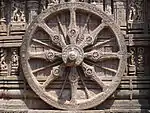Bhoi dynasty
The Bhoi dynasty were a medieval Hindu dynasty from the Indian subcontinent, which originated in the region of historical Odra (most of present-day Odisha, Northern coastal Andhra and southeastern parts of current West Bengal) that reigned from 1541 to 1559 CE. The dynasty was founded by Govinda Vidyadhara, who had usurped the throne from the weaker Gajapati dynasty rulers as the kingdom started weakening but had a short-lived reign as ruling chiefs of Odisha as the ensuing internal rivalries and constant threats of invasions rendered them weak and were eventually overthrown by Mukunda Deva of Chalukya dynasty in 1559 CE.[1][2]
Bhoi dynasty | |||||||||||||||
|---|---|---|---|---|---|---|---|---|---|---|---|---|---|---|---|
| |||||||||||||||
| Capital | Cuttack (1541–1559) Khurda (1568–1804) Puri (1804-1947) | ||||||||||||||
| Common languages | Odia | ||||||||||||||
| Religion | Hinduism | ||||||||||||||
| Government | Monarchy (1541-1559) Kingdom (1568-1804) Titular (1804-1947) | ||||||||||||||
| King (Odisha) | |||||||||||||||
• 1541–1548 | Govinda Vidyadhara | ||||||||||||||
• 1548–1557 | Chakrapratapa | ||||||||||||||
• 1557–1558 | Narasimha Jena | ||||||||||||||
• 1558–1559 | Raghuram Chhotaraya | ||||||||||||||
| Historical era | Medieval India Early modern period | ||||||||||||||
• Established | 1541 | ||||||||||||||
• Disestablished | 1804 | ||||||||||||||
| |||||||||||||||
| Today part of | Odisha, India | ||||||||||||||
Under Ramachandra Deva, The dynasty shifted its power centre to Khurda as Mukunda Deva himself lost his throne in 1568 CE to the Sultans of Bengal who eventually lost to the Mughal Empire. During that period, most of the feudatory native states of Odisha became autonomous states in their own right and along with the dynasty remained vassals of the Mughal Empire until the advent of the Marathas who occupied Odisha in 1751. With the defeat of Marathas to the British East India Company in 1803, the dynasty became their vassals but by then had already weakened as their territories and power kept diminishing. The kingdom was eventually annexed to the British Empire after the King led a failed rebellion against the British in 1804 and were ultimately exiled to Puri where the dynasty remains to this day as nominal heads of the House. Nevertheless, they retained the titular legacy of the historical ruling chiefs of Odisha and also retained the administrative control of the Jagannath Temple at Puri.[3]
History
As rulers of Odisha
With the death of Prataparudra Deva of the Gajapati dynasty in 1540 and a succession of weak rulers lead to the rise of political instability in the kingdom as there was a rise in internal squabbles, economic decline and increasing threats of invasions from both south and northern parts of the subcontinent. In the political chaos, the Gajapati Kingdom started weakening as Prataprudra Deva's successors were unable to maintain political authority. Taking de facto control of the situation, the general and minister of the kingdom, Govinda Vidyadhara decided to take the opportunity by murdering the successors of the Gajapati king and usurped the throne of Odisha, thus laying the foundation of the Bhoi dynasty as the ruling monarchs of Odisha.
Under his reign, the kingdom was still undergoing political upheaval as the were rebellions in different provinces and conflicts with the neighouring Qutb Shahi rulers of the Golconda Sultanate. His 7 year reign came to an end in 1548 and was succeeded by his son Chakrapratapa whose 8 year reign came to an end when he was killed by his son Narasimha Jena in 1557. Around the same time, the influence of Mukunda Deva Harichandan of the Chalukya dynasty began to grow at the court. He was eventually successful in overthrowing him and placed the King's younger brother, Raghuram Chhotaraya on the throne, making him his puppet ruler while also simultaneously fending off the influence of his rival, general Danai Vidyadhara, a relative of Govinda Vidyadhara. The short-lived nearly two decade old reign of Bhoi dynasty as the ruling Kings of Odisha finally came to an end when Mukunda Deva overthrew the puppet king and took the throne for himself in 1559.[4]
Rulers
Kings of Odisha
- Govinda Vidyadhara (1541–1548)
- Chakrapratapa (1548–1557)
- Narasimha Jena (1557–1558)
- Raghuram Chhotaraya (1558–1559)
Bhoi dynasty's reign as rulers of Odisha lasted nearly two decades, as they were deposed by Mukunda Deva in 1559. The dynasty then shifted its power centre to Khurda where they continued as Rajas of Khurda.[5]
Kings of Khurda
- Ramachandra Deva I (Abhimanyu Indradyumna) (1568-1600)
- Purusottam Deva (1600–1621)
- Narasingha Deva (1621–1647)
- Balabhadra Deva (1647–1657)
- Mukunda Deva I (1657–1689)
- Dibyasingha Deva I (1689 – 1716)
- Harekrushna Deva (1716–1720)
- Gopinath Deva (1720–1727)
- Ramachandra Deva II (1727–1736)
- Birakesari Deva I (Bhagirathi Deva) (1736–1793)
- Dibyasingha Deva II (1793–1798)
- Mukundeva Deva II (1798-1804)
The Rajas of Khurda continued to rule the region well into the early 1800s but by then their power had diminished. Then the Raja of Khurda along with other local chieftain led a series of rebellions against the British which was suppressed and the Raja of Khurda was later exiled to Puri.
Kings of Puri (titular)
- Mukundeva Deva II (1804-1817) (exiled and continues as Raja of Puri)
- Ramchandra Deva III (1817-1854)
- Birakesari Deva II (1854-1859)
- Dibyasingha Deva III (1859-1882)
- Mukundeva Deva III (1882-1926)
- Ramchandra Deva IV (1926-1956)
- Birakisore Deva III (1956-1970)
- Dibyasingha Deva IV (1970-current)
See also
References
- L.S.S. O'malley (1 January 2007). Bengal District Gazetteer : Puri. Concept Publishing Company. p. 30. ISBN 978-81-7268-138-8. Retrieved 2 February 2021.
- Majumdar, Ramesh Chandra; Pusalker, A. D.; Majumdar, A. K., eds. (1960). The History and Culture of the Indian People Volume=VI: The Delhi Sultanate. Bombay: Bharatiya Vidya Bhavan. p. 370. Retrieved 2 February 2021.
- "History". Government of Orissa. Retrieved 2 February 2021.
- Manas Kumar Das, HISTORY OF ODISHA FROM 1435 TO 1803 AD) (PDF), DDCE Utkal University
- Bhaskar Mishra (July 2011), The Traditional Role of Gajapati Maharaja in Shri Jagannath Temple (PDF), Orissa Review
